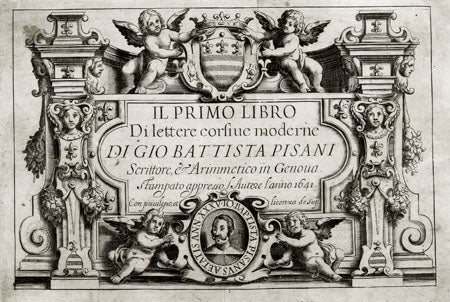
Il Primo Libro di Lettere corsive moderne.
Oblong 4to. [19.5 x 28 cm], [41] ff. Including engraved title and 40 plates of writing samples. Bound in contemporary cartonnage and vellum, title and some pages rather dog-eared. Foxing, light watermarks and fingersoiling, practice work on some leaves.
First edition, and evidently the most complete copy extant, of this calligraphy manuel by a Genoese writing master. Notwithstanding its rich mercantile culture and the educational infrastructure that supported it, few such manuals were published in Genoa. Of five other copies listed by Becker, that described in Marzoli is the most complete, containing 32 plates (including title and six plates by the writing master Scipioni Leoni); this present copy contains an additional nine. Of these 41 plates, nine are signed by Leoni. Three have elaborate engraved borders; the title engraving features a portrait of Pisani flanked by two putti.
Pisani’s “First book of modern cursive letters” eschews charts and practice tables in favor of a sequence of brief discourses on the subject of
The classic Italian chancery hand (lettera mercantile) predominates, with its more baroque elements displayed in lavish epistolary greetings that Pisani inscribes as samples of proper business correspondence. Leoni’s contributions are in a decidedly more decorative script, distinguishable from Pisani’s by their inked-in ball-terminals, serifs and swooping tails. These examples are followed by four final plates depicting an alphabet of capital initials over floral and scrolled designs.
This volume was unquestionably employed in the classroom: the pages are occasionally scrawled or traced with crude letters, and the verso of one leaf in particular exhibits a child’s drawing of what appears to be a nude woman being suffocated by a snake.
Giovanni Battista Pisani (ca. 1606-?), a Genoese calligraphy and writing master, also wrote on accounting and arithmetic (1646, 1650).
* Osley p. 162 (no collation). Becker, Practice of Letters 68 lists incomplete copies owned by Newberry, Harvard, Berlin and Marzoli.
Price: $0.00
